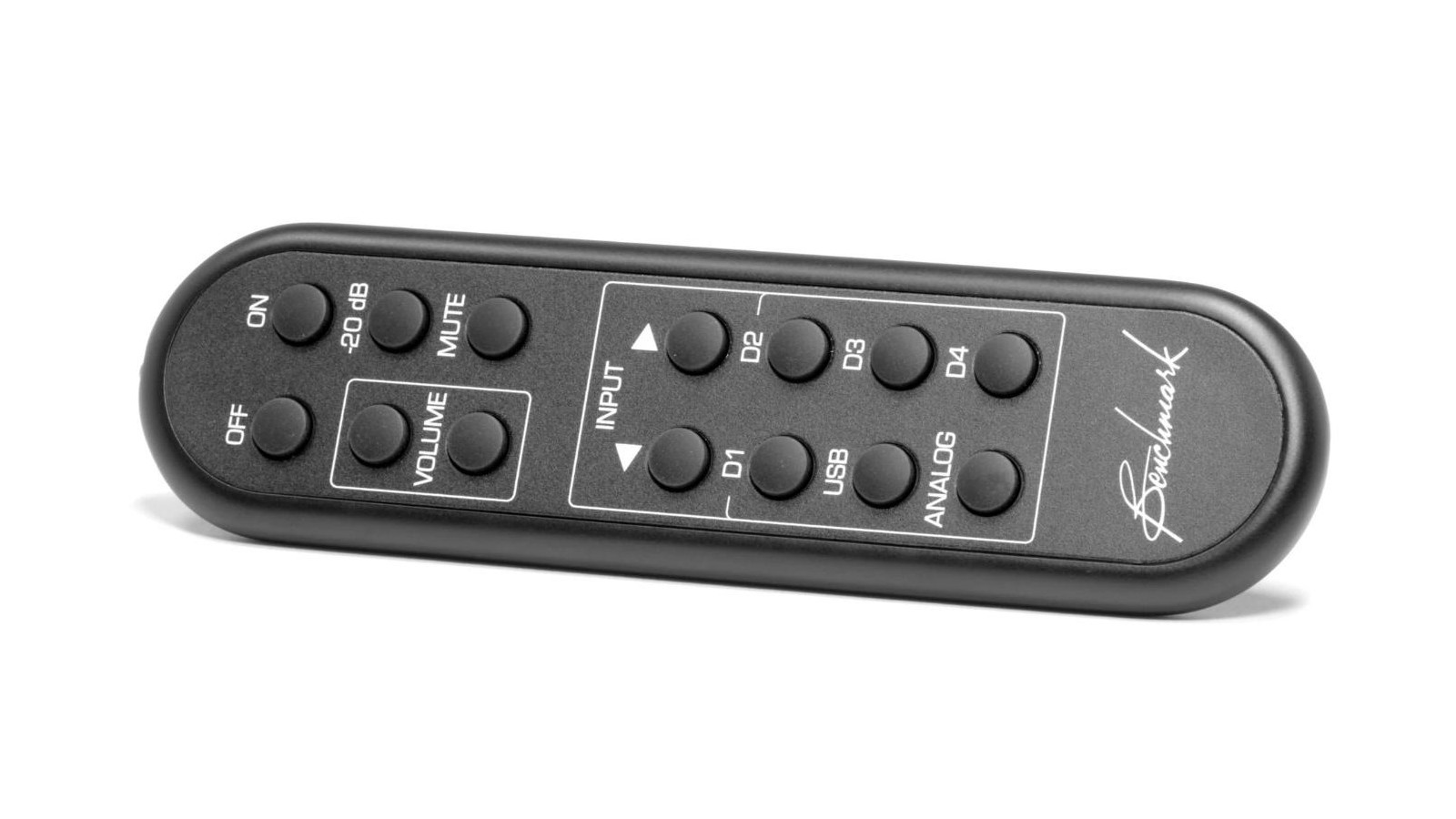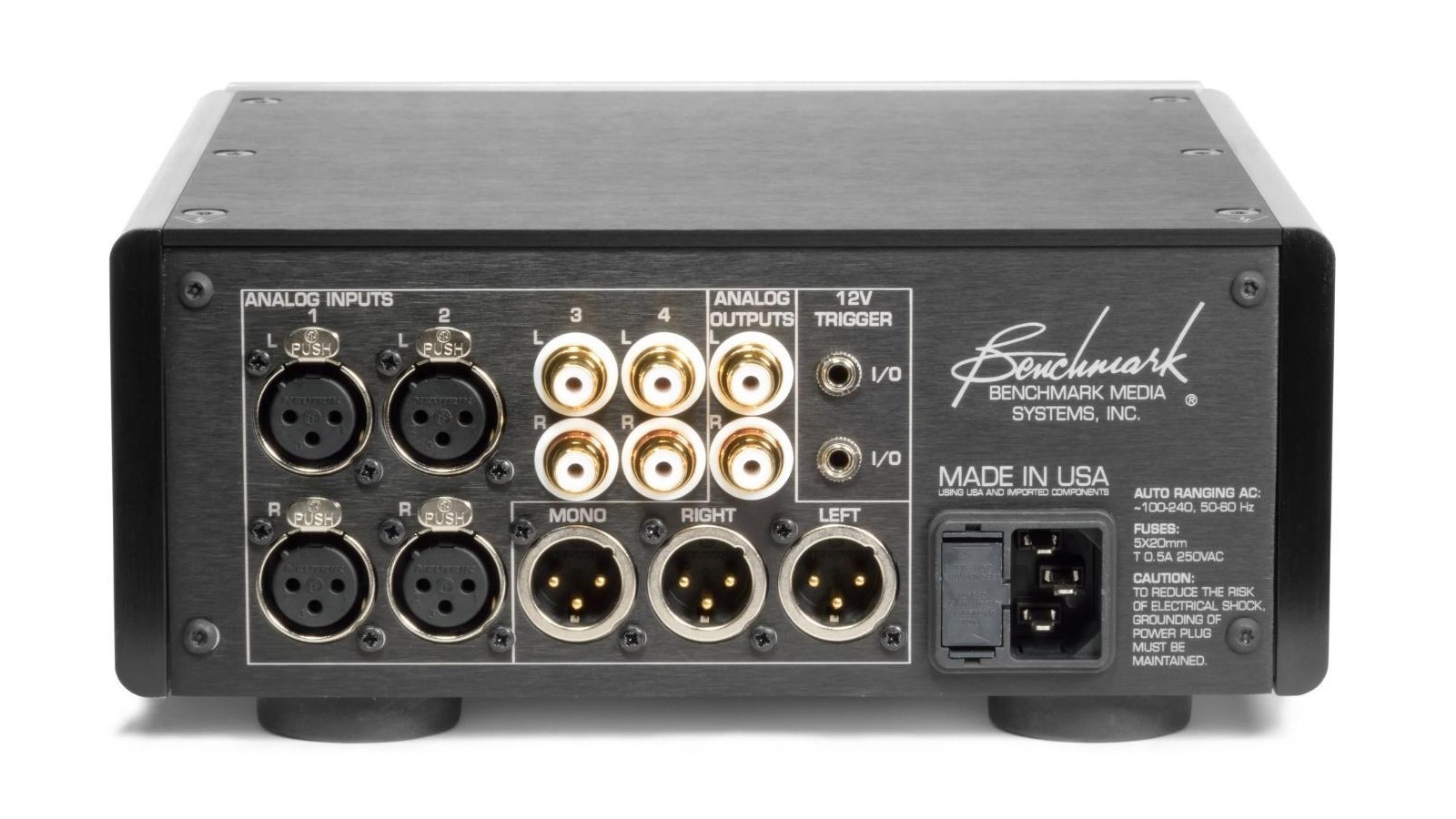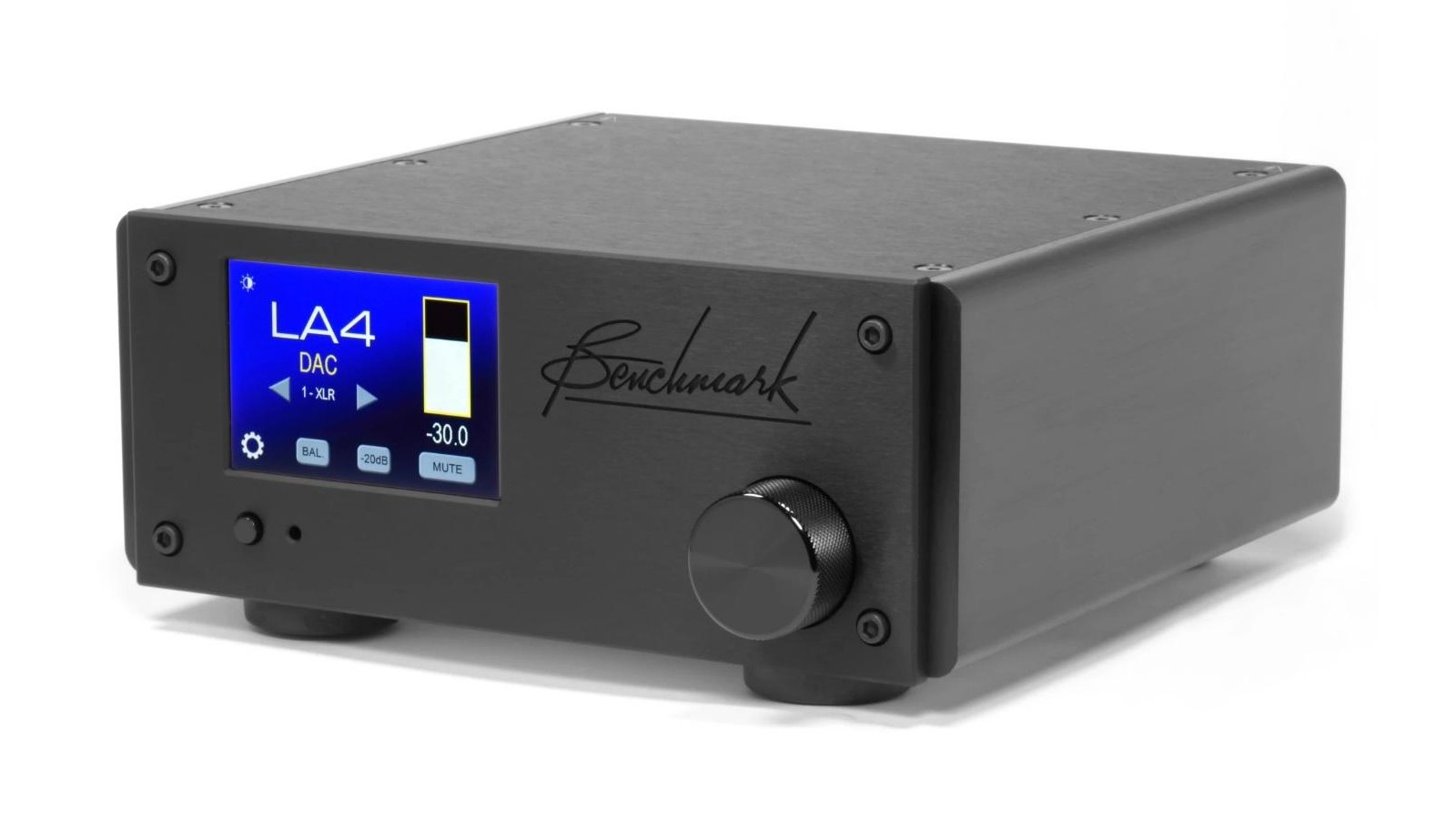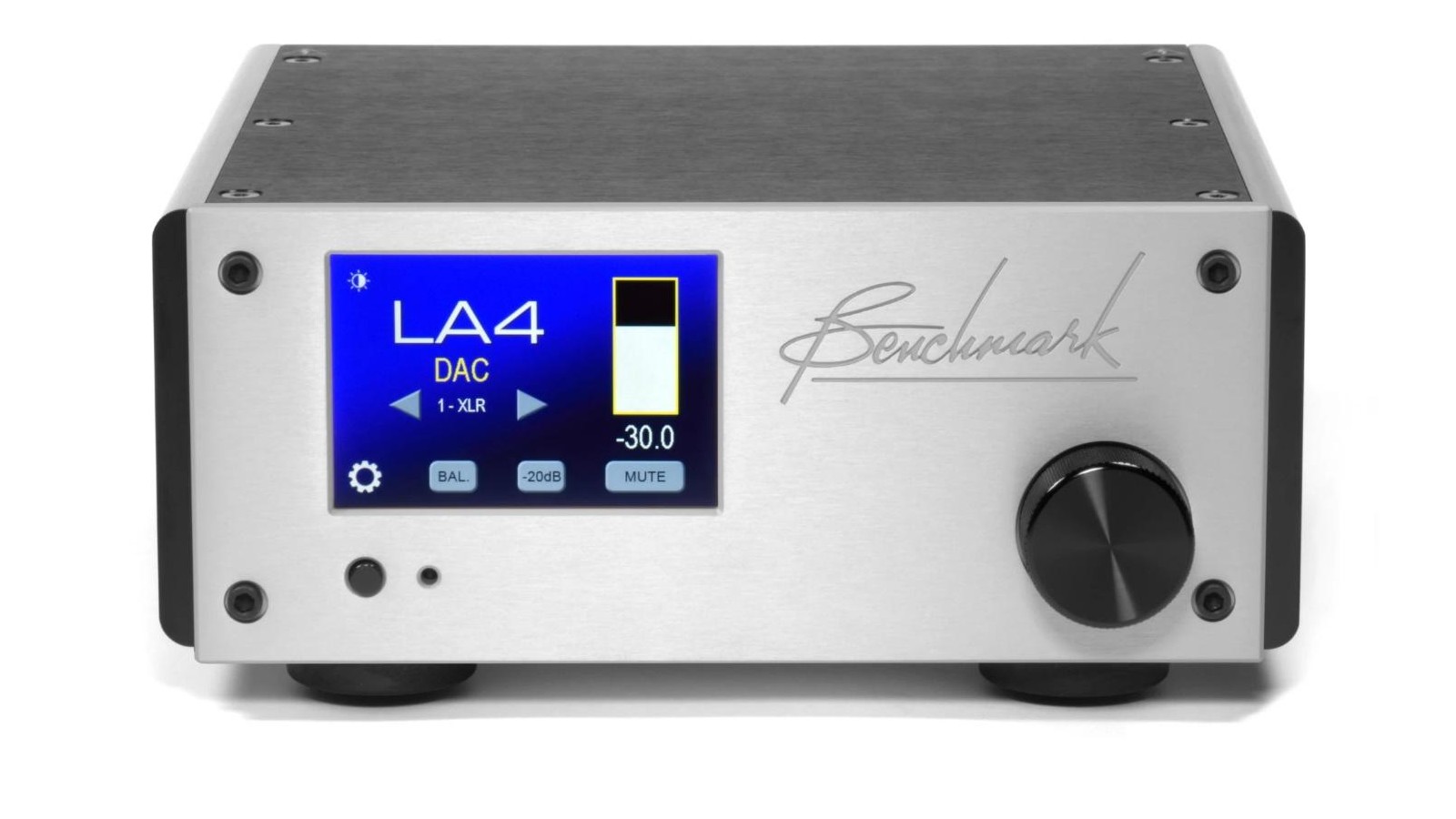I must admit I am a bit late to the party on reviewing this preamp, but as the saying goes, better late than never. Released in the last quarter of 2018 this preamp has garnered quite a following and many stellar reviews. Since my reviewing focus in 2022 is on front-end components I felt it was incumbent on me to hear for myself what all the fuss was about. Benchmark was kind enough to send me a complete stack of components as they insisted it was important to hear the impact of a “complete Benchmark system”
While I did audition the LA4 with their matching AHB2 amp and DAC 3 I also evaluated the LA4 with several other amplifiers.
Because of the aforementioned numerous reviews that are available, I am not going to rehash every operational feature of the LA4 and I will spend less time than I normally do on describing the unit because I want to focus more on the sound of the unit and how it impacted my system.
I also want to point you to the excellent Benchmark website. It offers a tremendous amount of information about their products and the very informative downloadable owner’s manuals will answer almost any question you may have.
However, my favorite part of their website is the “Application Notes” section.
This is an extensive section discussing a plethora of subjects like balanced vs single-ended, listening vs measuring, speaker sensitivity and amplifier power, and on and on.
It is well worth your valuable time to visit it and read through the information on the various subjects. You will, more than likely, learn something you didn’t know. I know I did.
Let’s get to it…
The first thing you notice about the LA4 is its size. Its small footprint measures approx. 8.65-inches wide and just under 4-inches tall. Including the feet. Overall depth including knobs and connectors is just shy of 9.5-inches. The front panel features a large LED touchscreen from which you can rename the inputs, individually adjust the gain level, delete the input, and adjust screen brightness along with a number of other features and functions.
Despite its small chassis, it has ample connectivity on the rear that includes four inputs, two RCA and two XLR. Outputs include two RCA jacks, a pair of XLR jacks, and a single XLR mono sum jack. All the outputs are individually buffered.
I specifically mention this because individually buffered outputs virtually eliminate any interaction caused by hooking up a powered subwoofer to the outputs which is a common scenario. Many preamps have multiple outputs that are simply wired in parallel. When you plug two devices in the outputs, they “see” each other and can impact the sound of both.
It is always good to know the output wiring configuration of your preamp if you are going to hook up more than one stereo amp to it and in particular, a powered subwoofer whose input impedance is typically in the 10k Ohm range.
While the rear of the unit looks like it would be crowded, I can tell you that with my system I had every jack occupied except the XLR mono sum and found it to be well thought out and easy to use.
A quick look inside the unit reveals several multi-layer circuit boards that feature extensive use of surface mount devices and very short signal paths. The manual describes the circuit as using 100% analog fully balanced signal paths.
As for the circuit paths, it goes on to say:
The inputs are routed to a balanced pair of precision differential amplifiers. These drive two sets of fully-balanced 256-step volume controls. These balanced outputs from the volume controls drive the line output drivers. Each output connector has dedicated buffers.
benchmarkmedia.com
The optional metal remote control is a pleasure to use and fits my hand nicely. I would like it to have a different sized “Off” button that would allow you to distinguish it by touch. Every so often I would go to raise the volume and I would accidentally turn the unit off.

Of special note is the 256-step relay volume control which employs 40 precision relays and was developed by Benchmark engineers. Its development and design are central to the performance of the LA4.
If you want to take a deep dive into the technical end of this volume control you can find a detailed description of it in the Benchmark application notes at this link.
Wide Bandwidth Design
Before I dig into the sound of the LA4 it is important to know that it employs a wide bandwidth design. The LA4’s bandwidth is specified at .2 Hz to 500k Hz. I have been a big fan of wide bandwidth designs over the years, ever since I heard about Stewart Hegeman’s designs in the 60s and 70s. In particular, the groundbreaking Harmon Kardon Citation amp and preamp series and his own company’s HAPI 2 preamp. All of these employed Stewart Hegeman’s wide bandwidth design thinking. A Hegeman HAPI 2 preamp still resides in my collection of components. I occasionally pull it out and I am always impressed with its full range cohesive clarity and overall engaging presentation of music.
Most of the wide bandwidth designs I have heard exhibit similar characteristics. Brands like Spectral, Goldmund, Electrocompaniet, darTZeel, and many others typically exhibit a purity in tone with superb timing and speed that is quickly apparent and the LA4 proved to be no exception.
The Sound
I am going to approach this section of the review a bit differently than I normally do. I want you to know that this is not going to be another conventional review of the Benchmark LA 4. Frankly, there are several very good reviews already out there including one from our own Drew Gagliano. I encourage you to read them.
I will eschew the usual litany of album examples and I will focus on how this excellent component globally impacted my system and my listening enjoyment.
It didn’t take very long for me to grasp how the LA4 impacted the sound of my system. Replacing the zero gain, output buffered, Denafrips Athena with the Benchmark LA4 yielded a change that was quickly apparent in several areas. Notably were; bass, upper midrange, treble, low-level listening, and the ability to distinguish the colorations of other components that were contributing to my overall sound.
Let’s break these down.
Bass and Upper Midrange/Treble
Benchmark attributes its ability to deliver a correctly timed full range signal to its wide bandwidth design. From their website and manual:
The bandwidth of the LA4 extends from 0.01 Hz to over 500 kHz. This means that the LA4 delivers very precise amplitude and phase accuracy over the entire audio bandwidth. Wave shapes are accurately reproduced, and the entire spectrum is delivered with precise timing. The LA4 will deliver musical overtones with life-like accuracy. This means that musical instruments are rendered without changing their sonic character. Bass is delivered with the correct timing relative to other frequencies. Most audio products deliver the bass slightly late. Bass that arrives late tends to mask high frequency details. In contrast, bass that arrives with the correct timing will sound deep, full and well damped. For this reason, all Benchmark products feature low-frequency extension to 0.1 Hz.
The extreme 500 kHz high-frequency extension delivered virtually perfect timing at the high end of the audio spectrum. High frequencies are delivered with precise timing relative to low and mid frequencies. In addition, the left-right differential phase is virtually perfect at 20 kHz. These timing characteristics preserve the precise placement of voices within a well-defined 3D stereo image.
benchmarkmedia.com
What does this translate into sonically?

Timing…Timing …Timing…
Timing is a hard listening trait to put into words, but it is quite apparent when you hear it. Permit me to tell you about a seminal event in my listening career.
I was fortunate to be a witness to the Wilson Audio Team setting up a pair of Wilson loudspeakers before the opening of one RMAF several years ago. Once they had determined the most favorable position of the loudspeaker the next step was to get the tonal balance correct for the “Money Seat”. They chose a classical piano selection to play. The selection sounded very good but one listener, a classically trained pianist, mentioned they were not happy with the integration of the leading transients of the notes being played. He said it sounded a bit “hard and tense” and seems to be “wrong harmonically.”
It was at that point that they decided that the adjustable tweeter on the speaker needed to be moved to address this. Now since what they were addressing was a “bit of hardness” my thinking was that they were going to move the tweeter back one notch….. but I guess that is why I am not a speaker designer because, to my surprise, they moved the tweeter forward one notch.
The music was queued up again and the difference in the integration of the leading transient and overall note was very audible. It was as if you went from a three-way loudspeaker to a one-way loudspeaker and your brain simply felt more relaxed and the notes sounded more natural.
I can remember that experience like it was yesterday and I tell you this story because I had that same experience when I put the LA4 into my system. I immediately thought of that day in the Wilson demo room and the first word I wrote down in my LA4 listening notes was “timing”.
The top end of this preamp is a pleasure to listen to.
Acoustic guitar, piano, and harmonica among many other instruments are presented with speed, clarity, and coherency that made them sound more “present” in the room and less like a recording.
As for the bass, while it seems counterintuitive, I have come to understand that the quality/timing of bass has a huge impact on the quality of the treble. Get the bass impulse response (timing) correct and the treble will open and take on a more natural feel as you listen.
Benchmark offers this insight:
Bass is delivered with the correct timing relative to other frequencies. Most audio products deliver the bass slightly late. Bass that arrives late tends to mask high frequency details. In contrast, bass that arrives with the correct timing will sound deep, full and well damped. For this reason, all Benchmark products feature low-frequency extension to 0.1 Hz.
benchmarkmedia.com
Indeed, I found the bass response to be some of the most natural I have had in my room and very well integrated with the rest of the music.
When the timing is right you will feel that your brain is not working as hard to “assemble “ the music. This translates into a more relaxed feel to your listening experience. Don’t get me wrong. This relaxed feeling is not a result of the sound itself presented as more “laid back”, less “forward“ or less “transparent”. Quite to the contrary. I found the sound to be more transparent with considerably less need to increase the volume to hear subtle details.
This segues nicely into another topic I want to discuss.
Low-Level Listening
One of the indicators I often fall back on to make a quick judgment of a system’s overall performance is my desire to “turn it up.” When I am listening to an unknown system I often like to turn it up to a realistic level and see if I enjoy listening to it and whether I want to turn it up a bit more or am I diving for the remote to turn it down.
I often have friends over to chat about audio and, when we are talking, the audio system is usually on in the background. I noticed that during the time I had the LA4 in the system, my audio buddies would specifically comment on how good the low-level sound was.
I am not typically a low-level listener. One reason is that I have a listening room that is detached from the main house and I don’t have to be mindful of disturbing family members. The other is that I like to listen to music at a level that is similar to being at the performance. But the main reason is that I find that when I turn down the volume, the system typically loses its ability to engage me. Details go away and dynamic swings are compressed. It sounds like a big radio playing and not a high-fidelity stereo system.
Not so with the LA4. I caught myself on multiple occasions listening for an extended period of time at lower levels than usual, and actually enjoying it!
Dynamic expression was still present, and the music still had the ability to engage me from a soundstage and low-level detail perspective. It was like listening to a lower volume version of the “big” sound I was used to. Perhaps it is because of its very low noise floor, or perhaps it is another attribute of wide bandwidth design. I don’t know what to attribute it to but it was unique in my experience.
The Paint Store
I noticed one other aspect when I added the LA4 to my system, it became much easier to quantify hear the sonic coloration of cables and components.
My system consists of several sources including multiple streaming platforms and vinyl/phono preamp options along with my Studer A810 reel to reel. As a result of the multiple sources, I have the need for a control center. I also reside in the camp that thinks that a preamp in front of an amplifier almost always sounds better than an amplifier being driven directly by a source.
As I thought about why I had an easier time pinpointing colorations with the LA4 in my system, I thought about a trip to the paint store.
Stay with me here.
When you go to the paint store to have colors mixed, they start with a neutral white base to which tint is added to make the color you want. If you are getting three different paints mixed, then there are three different formulas used with that base.
Now consider what would happen if the base was changed. You would have to reformulate all 3 colors, each requiring a different adjustment, to get them right.
However, if the base remained neutral, you would be able to change the one color and not affect the remaining two.
Having a very neutral base, or preamp in audio terms, in a system with more than one source greatly relieves you from “chasing your tail” when adjusting the system. You are not injecting one coloration on top of another.

Conclusion
I recognized that this is a somewhat unconventional review but it is intended to be more of a supplement to the earlier reviews I mentioned and not another “me too” review that didn’t offer any different insight into the product. That doesn’t do, you, the reader any good.
After a few months of having the LA4 in my system, I began to think about how I was going to describe what I was hearing. Ultimately, it turned out to be easy. I happened to be digging around on the Benchmark website and stumbled on this:
When you see the Benchmark name on an audio product you can be assured that the product has been designed to be sonically neutral and transparent. This means that we are focused on building products that have an accurate impulse response. It also means that our products produce very little distortion or noise. The accurate impulse response is an indication of our focus on maintaining an accurate phase response, as well as very wide and flat frequency response. Transparency can be measured and defined by these parameters.
If you are looking for audio products that will change or enhance the sound of your music, you have come to the wrong place. If you are looking to add a warm veil of even-harmonic distortion, you have also come to the wrong place. On the other hand, if you are looking for accurate, clean, and transparent audio equipment, you will enjoy Benchmark products.
benchmarkmedia.com
I agree with Benchmark and would add, that the Benchmark LA4 is simply the most transparent, least colored, and most revealing component I have had in my system to date. I look forward to it joining my stable of reference components. Highly recommended.
MSRP: $2,499.00 w/out remote
MSRP: $2,599.00 w/ remote
Website: benchmarkmedia.com
Associated Equipment used in this review:
ANALOG SOURCE: AMG Viella 12JT Turbo turntable /tonearm & VIV Labs Rigid Float Tonearm
Benz Micro LP-S MR cartridge & Grado Statement 3
HANA ML Mono MC Cartridge, Denon 103R
PHONOSTAGE: Mod Squad Phono Drive, Tom Evans Groove+ SRX, Parasound JC3+
DIGITAL SOURCES: Aurender S-10 server/streamer, ROON Nucleus, PS Audio PST SACD transport
McCormack DAC-1 Platinum, McCormack SST-1 CD transport, Benchmark DAC3
NETWORK: EtherREGEN network switch
OPEN REEL: Studer A 810 with Flux Magnetic Heads optically aligned by JFR Magnetics and direct-wired
into a King/Cello tape preamp
LINE STAGE: The Truth v.3 (passive), Benchmark LA4, Denafrips Athena
POWER AMPLIFIERS: Pass Labs SIT 3, SMC Audio DNA-1 Platinum, PS Audio M1200 monoblocks
Benchmark AHB2, Quicksilver MS190
SPEAKERS: Acoustic Zen Crescendo II, Pure Audio Project Treo 15 Classic,
CABLES: Acoustic Zen, Audience, Triode Wire Labs, ASI Liveline, Analysis Plus
A/C POWER: Dedicated 20 amp lines, P.I. Audio UberBUSS, outlets from
Audience, Jena Labs, P.I. Audio.
ACCESSORIES: SMc Audio UFO Isolation Base, Stillpoints Ultra’s, Apertures & LPI, VPI Bricks


I have gustard p26 and schiit freya+ . Actually was satisfied with both though gustard presented a composed ,clean and relaxed sound.
With the itch to own the best preamp(measurements wise) got myself LA4.
My poweramp is Emotiva DR 2 and dac is Denafrips Pontus 2.
This is the first time I am struggling to get an enjoyable sound to my taste.
Sound is thin. Bass is not impressive. Due to this high frequencies appear to be sharper.
Depth perception is less. Currently, switching the preamp after one hour of listen.
Am waiting for it to burn in. 2 weeks already.
Speakers are Lsim 707s
Hello,
The Benchmark is actually showing you that the rest of your system is not up to scratch. It’s really just that.
Hello,
Your da is fine but the rest of the system is not at the same level as the preamp. And it does sound thin the first weeks but then it should sound glorious. Well it shouldn’t sou’d like anything. It let’s you hear your other components. For better or for worse.
Hello, two items. The retail price w/out remote is actually $2999.00. Please update your article as $500 bumps in price can dissuade people from auditioning. To Raman’s comment, in addition to “burn in”, I would suggest that not all components play nicely together. If possible, switch in another amp (or even DAC) to see if the sonic impressions change.
Hi John…
I just checked the Benchmark website and the LA4 price is still shown as $2499 with no remote and $2599 with remote..
The Benchmark ABH2 amplifier is 2999.00
and yes…you are correct…. System synergy is a huge factor with any setup. The typical listener has their system balanced/voiced to their liking for their equipment. If you inject a new component into that system it may not work well with that voicing. All you can conclude is that the component is not a good match with that system. It is why ,as a reviewer, I have three very different systems that allow me to determine the overall character of a review piece once I have heard it in the three different setups. Its sonic signature will typically consistently present itself in all three systems and , at that point, I can feel comfortable reporting about it.
do you feel that benchmark would be a good match for my parasound a21+ amp ?
Hi Stephen,
Well…. it certainly could be a nice match. The only way to know for sure if it is a good match for you is to try it in your system.
Benchmark makes that easy with their 30 day risk free audition policy. They are very responsive and easy to deal with. I would encourage you to take advantage of it.
Should it turn out you don’t like the match , you will have still learned a lot by listening to it.
I have what I think to be a revealing system. ATI 6002 AMP, LA-4 line amp, Meitner MA -1 Dac , Project RS2T Transport, SVS SB 4000 Sub running balanced to the mono on the rear of the LA-4 Stream Qobuz Rock and Roll, At home always at a concert. Wonderful, Very happy with my LA-4 Robert TN
Hello Audio Beatnick. I am new to your site. I have a question, and, to make sense, I have to give my particulars. I am in my 60s and have always favored ribbon type or Quad ‘stat. speakers. Am In a small condo, well set for bookshelf spkrs and a sub. Joni Mitchell, Burl Ives, Teresa Stratas, Claudio Arrau Mozart on Philips. VPI Prime/Fat Boy/ Lyra Delos. 3000?+ LPs cleaned on VPI vacuum. (No time to go back using Kirmuss type sonic). Rogue Ares Magnum phono stage into the line stage of the Berning TF-10 1979 vintage pre (the actual unit that JG Holt used to own). Quad 909 amp and Bohlender Graebner lil bkshlves and sub from 2008. Time to buy a new amp, methinks. LTA ZOTL 10 mK II? Or the newly reviewed Benchmark LA4? Or a First Watt? Or maybe Prima Luna EVO 100? I plan on going to the DS Audio cartridge system in due time. Much thanks for a well reasoned well written buncha stuff.
Greetings Donn,
That is a nice selection of equipment you have on hand and I am sure it is a musical treat to listen to.
Unfortunately, the Benchmark LA4 is a Line amp and not a replacement for your Quad 909.
The other amps you mention are quite good. I will say that I do find my First Watt SIT 3 to be quite sensitive to speaker load with it preferring higher impedance speakers.
One other comment: I have owned both the TF10 and TF12 and enjoyed then both. However, both have a bit higher than average output impedance, so you need to be aware of the input impedance of any amp you look at and make sure it is high enough to work correctly with the Berning.
BTW… The DS Audio cartridge will be a treat for you to hear.
Thanks for reading The Audio Beatnik -ken
Bought my LA4 a month ago
Connected to my ATC SCM40a, Cambridge 851N streamer…..
Cables by Grimm Audio (TPR balanced)
My god, I’m hooked!!!!
Soundsstage, detail, pace and rythm, total “clearness”, it’s all there
The LA4 is, to my ears, totally transparent. I was a tube guy, CAT and 300B VAC, for many years, but finally there’s are SS devices that do not destroy the emotional content of the music.
My digital setup is Aurender, Esoteric K01xs; analog is VPI scoutmaster with a middling Koetsu and Sutherland Duo. The LA4 feeds a Pass Labs XA 25, into Rockport Atria ii speakers.
I hear nuances of expression in playing that were previously hidden, and the ability of the system to play from pppp to ffff is astonishing. That said some early CDs are not pleasurable, many of the SACD issues of the ShadedDogs are outstanding. The sound was superb with the previous preamp, but the LA4 seemed to remove a layer and choral music in particular is life changing, slightly tongue in cheek, in that trying to use the system as background music doesn’t work, I get totally immersed in the performance.
The LA4 is as good as it gets, but will reveal any weakness.